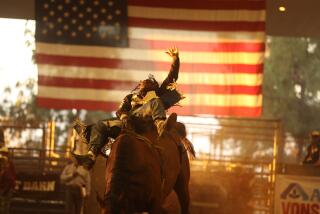Endangered Man
- Share via
Motorists drive toward him into the blinding glare of a late afternoon sun. Their eyes first confront the ropes dangling from his saddle, then travel to his hands poised to light a cigarette, until they stop to meet a squint 300 times as large as their own. Defying the finale of nearly every western, the Strip’s storied Marlboro Man rides east--away from the sunset.
“When you see him, the wonderful, surreal juxtaposition with the Chateau Marmont, the sky and the hills above,” says architect and author Alan Hess, “that mix is what says ‘L.A.’ Things are completely out of place, yet there they are and they’re undeniable.”
At 60 feet, the Marlboro Man stands as a gateway to West Hollywood, an introduction to the Strip’s famous cacophony of billboards, a monument to a habit--and an era--no longer considered medically correct. So incorrect, in fact, that the man who has lit up that spot since 1976--in about half-a-dozen different incarnations--may be riding into the sunset by August. That is when the Food and Drug Administration’s newly approved tobacco billboard regulations are scheduled to take effect.
This summer, in a Rose Garden ceremony approving the rules, President Clinton issued a death sentence for the famed billboard when he decreed that “Joe Camel and the Marlboro Man will be out of our children’s reach forever.” The Strip’s Marlboro Man passes one restriction that forbids billboard advertising within 1,000 feet of playgrounds and schools. (A nearby Hebrew academy is just out of lasso’s reach.) A second regulation, however, limits tobacco advertising to black and white text only, no color images.
Not surprisingly, Philip Morris and a gaggle of tobacco companies immediately filed suit. “We’re opposed to the FDA’s plan,” says Tara Carraro, a Philip Morris spokeswoman. “This interferes with our rights to market a legal product to adults.” As for the Marlboro Man’s fate, she says, “We are in litigation with the FDA, so we certainly can’t speculate at this point.”
Outdoor Systems, which owns the billboard and sells the ad space, considers the Marlboro Man its “most spectacular site in Southern California,” says real estate manager Scott Christensen. While he will not divulge how much Outdoor charges for the billboard, “it’s safe to say it’s in excess of $25,000 a month,” he says, “probably the most expensive on the Strip.” Outdoor is in the midst of renegotiating a five-year lease with Philip Morris (which will be erecting a new man for the site in January). Christensen assumes that even though the Marlboro Man may be thrown from its horse, Philip Morris owns so many other companies--Kraft General Foods, Miller Brewing and Oscar Mayer, among others--that filling his saddle won’t be difficult.
Should the Strip be guarded by a 20-by-60-foot hunk of Velveeta cheese? A giant Genuine Draft? A three-story high wiener?
An attempt to landmark the billboard is unlikely. Only one sign in the Los Angeles area holds official historic-cultural monument status, and it spells “HOLLYWOOD.” Besides, just nominating the famed smoker, says Hess, would require finding a balance between aesthetics and morality that the Marlboro Man would no doubt flunk. “I’m not enough in favor of smoking to feel that it should be preserved for that reason alone,” he says. “Its day of big, surreal sculptural billboards is still with us. We should keep all of its lessons.”
West Hollywood City Councilman Steve Martin is already casting the Marlboro Man’s replacement. “That billboard will be a major point of interest,” he says. “I see Madonna versus DeNiro. Frankly,” he says, “I’d be glad to see a giant Calvin Klein ad there.”
Perhaps, given West Hollywood--and L.A.’s--fervent anti-smoking climate, the Marlboro Man has always been pointed in the right direction, headed down Route 66 in search of a sane place--like the Mojave Desert--to light up and take a long, unrestricted drag.
More to Read
Sign up for Essential California
The most important California stories and recommendations in your inbox every morning.
You may occasionally receive promotional content from the Los Angeles Times.










